
Afonso de Albuquerque, 1st Duke of Goa, was a Portuguese general, admiral, and statesman. He served as viceroy of Portuguese India from 1509 to 1515, during which he expanded Portuguese influence across the Indian Ocean and built a reputation as a fierce and skilled military commander.

Manuel I, known as the Fortunate, was King of Portugal from 1495 to 1521. A member of the House of Aviz, Manuel was Duke of Beja and Viseu prior to succeeding his cousin, John II of Portugal, as monarch. Manuel ruled over a period of intensive expansion of the Portuguese Empire owing to the numerous Portuguese discoveries made during his reign. His sponsorship of Vasco da Gama led to the Portuguese discovery of the sea route to India in 1498, resulting in the creation of the Portuguese India Armadas, which guaranteed Portugal's monopoly on the spice trade. Manuel began the Portuguese colonization of the Americas and Portuguese India, and oversaw the establishment of a vast trade empire across Africa and Asia.
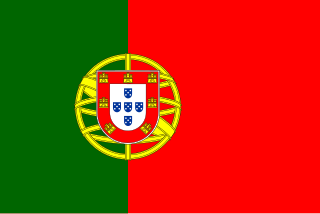
The State of India, also known as the Portuguese State of India or Portuguese India, was a state of the Portuguese Empire founded six years after the discovery of the sea route to the Indian subcontinent by Vasco da Gama, a subject of the Kingdom of Portugal. The capital of Portuguese India served as the governing centre of a string of military forts and maritime ports scattered along the coasts of the Indian Ocean.
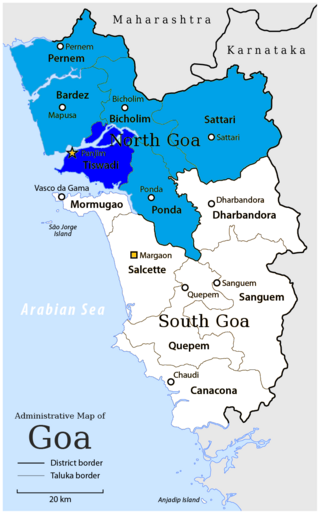
Tiswadi, formerly known as Ilhas, is a taluka in the district of North Goa, situated in the Indian coastal state of Goa. It is an estuarine island situated on the confluence of the Mandovi and Zuari rivers. It was one of the first territories to be annexed by the Portuguese in the 16th century. Both the state capital Panaji, and the erstwhile capital Old Goa lie within the sub-district. It is the biggest and the most populated of the six major islands between the Mandovi and Zuari rivers.

The Battle of Cape Rachado, off Cape Rachado in 1606, was an important naval engagement between the Dutch East India Company (VOC) and Portuguese Navy.

Portuguese control of Malacca – a city on the Malay Peninsula – spanned a 130 year period from 1511 to 1641 as a possession of the Portuguese East Indies. It was captured from the Malacca Sultanate as part of Portuguese attempts to gain control of trade in the region. Although multiple attempts to conquer it were repulsed, the city was eventually lost to an alliance of Dutch and regional forces, thus beginning a period of Dutch rule.
Timoji was a Bhandari privateer who served the Vijayanagara Empire and the Portuguese Empire, in the first decade of the 16th century. He claimed to have been born in Old Goa and escaped the city in 1496, during the conquest by the Adil Shahi dynasty of Bijapore. After his support in the 1510 Portuguese conquest of Goa, he was appointed aguazil of the city, for a short time.

NRP Afonso de Albuquerque was a warship of the Portuguese Navy, named after the 16th-century Portuguese navigator Afonso de Albuquerque. She was destroyed in combat on 18 December 1961, defending Portuguese interests in Goa against the Indian Armed Forces Liberation of Goa.
Rasul Khan was a general of Ismael Adil Shah, the Sultan of Bijapur, who commanded an army of Bijapur troops to recapture Goa from the Portuguese Empire in 1512. Khan's troops were repelled by forces commanded by Afonso de Albuquerque, culminating in the siege of the Benastarim fortress.

The Portuguese conquest of Hormuz in 1507 occurred when the Portuguese Afonso de Albuquerque attacked Hormuz Island to establish the Fortress of Hormuz. This conquest gave the Portuguese full control of the trade between India and Europe passing through the Persian Gulf.
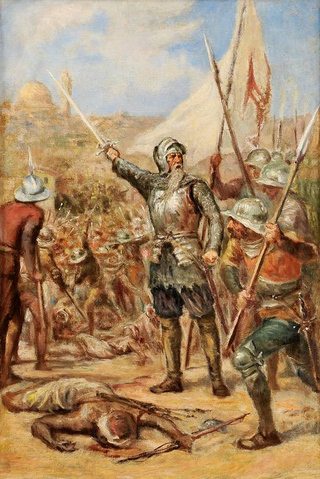
The Capture of Malacca in 1511 occurred when the governor of Portuguese India Afonso de Albuquerque conquered the city of Malacca in 1511.

The Portuguese conquest of Goa occurred when the governor Afonso de Albuquerque captured the city in 1510 from the Sultanate of Bijapur. Old Goa became the capital of Portuguese India, which included territories such as Fort Manuel of Cochin, Bom Bahia, Damaon, and Chaul. It was not among the places Albuquerque was supposed to conquer. He did so after he was offered the support and guidance of Timoji and his troops.
Sefer Reis was an Ottoman admiral and privateer who was active against the Portuguese in the Indian Ocean in the 16th century.
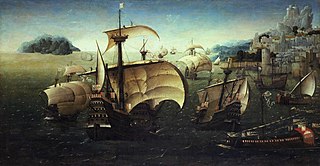
The War of the League of the Indies was a military conflict lasting from December 1570 to 1575, wherein a pan-Asian alliance attempted to overturn the Portuguese presence in the Indian Ocean. The pan-Asian alliance was formed primarily by the Sultanate of Bijapur, the Sultanate of Ahmadnagar, the Kingdom of Calicut, and the Sultanate of Aceh. It is referred to by the Portuguese historian António Pinto Pereira as "the League of Kings of India", "the Confederated Kings", or simply "the League". The alliance undertook a combined assault against some of the primary possessions of the Portuguese State of India: Malacca, Chaul, the Chale fort, and the capital of the maritime empire in Asia, Goa.

Garcia de Sá was a Portuguese nobleman, soldier, explorer, fidalgo of the Royal Household, who was the 14th ruler of Portuguese India as governor from June 1548 to 13 June 1549.

Malay–Portuguese conflicts were military engagements between the forces of the Portuguese Empire and the various Malay states and dynasties, fought intermittently from 1509 to 1641 in the Malay Peninsula and Strait of Malacca.
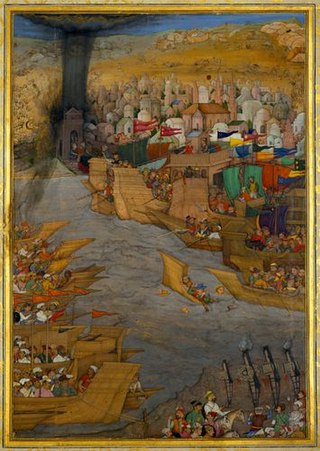
Mughal–Portuguese conflicts refers to the various armed engagements between the forces of the Portuguese Empire in India and the Mughal Empire, between the 16th century and the 18th century.

Adil Shahi–Portuguese conflicts refers to the various armed engagements that took place in India between the Portuguese Empire and the Sultanate of Bijapur, ruled by the Adil Shahi dynasty, whose rulers were known to the Portuguese as Hidalcão.

The First Luso–Malabarese War was the first armed conflict fought by the Portuguese Empire in Asia, and the first of nine against the Zamorin of Calicut, then the preeminent power on the Malabar Coast, in India. Hostilities broke out in 1500 and continued for thirteen years until the ruling Zamorin was assassinated and his successor signed a peace treaty with the Portuguese governor of India Afonso de Albuquerque.

The Portuguese intervention in Hormuz (1514–1515) took place amidst a power struggle within the Kingdom of Hormuz. After the poisoning of King Saif-ud-Din in 1512, Hormuz was divided between Turan Shah and Rais Ahmad, who held control with the support of Ismail I of Persia. The Portuguese, led by Afonso de Albuquerque, intervened, eventually assassinating Rais Ahmad and establishing Portuguese control over Hormuz.

















